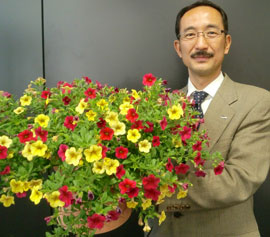10/26/2012
Behind the Business: Yatte Minahare!
Chris Beytes

Calibrachoa is one of floriculture’s most popular vegetatively grown annuals, second only to geraniums, with at least 15 series on the market from a dozen breeders, and more coming every season. And yet, 15 years ago, few in North America knew this crop even existed. That is, until EuroAmerican Propagators debuted Suntory’s Million Bells calibrachoa at their first Spring Trial in 1997. The first colors, Cherry Pink, Trailing Blue and Trailing Pink, sparked a calibrachoa craze that shows no signs of slowing.
Breeder Yasuyuki Murakami proudly shows off Million Bells.
Where did calibrachoa come from? We asked the breeders of Million Bells, Yasuyuki Murakami and Kenichi Suzuki, to share their story.
The two men were fruit and vegetable breeders working for Suntory, breeding grapes, barley and yeast for the company’s wine, whiskey and beer. Neither had any intention of breeding flowers. But the 113-year-old company encourages a spirit of “yatte minahare” (“go for it!”), and as biotechnology boomed in the 1980s, Suntory encouraged its breeders to seek out new projects. That led to flowers, including Surfinia trailing petunia and Tapien and Temari verbena, all of which were breakthroughs in their classes, helping launch the global vegetative annual trend.
Calibrachoa first came to Yasuyuki and Kenichi’s attention when they were working with petunias. At the time, the small-flowered wild species, native to North and South America, was part of the genus Petunia. Botanists knew of it, but horticulturists paid it little mind because of its small flowers and low seed productivity. But to Suntory’s breeders, with their “go for it” directive, it held exciting potential.
That potential was revealed to them during a plant-finding mission in 1988 on a desolate mountain slope in … well, they’d rather not say. But there, in the distance, on the edge of a steep cliff, grew a calibrachoa with an amazing number of striking pink flowers. The two breeders had to overcome their fear to reach it. And while that particular species didn’t prove to be useful to their breeding efforts, it revealed calibrachoa’s potential. Over the next five years, the breeders would collect hundreds of species until they discovered the species that would form the cornerstone of the first commercial series.
There were many challenges during those five years, including battling too-aggressive growth, stretching stems, late flowering, flowers that closed on cloudy days, poor branching, long-day flowering and various root rot diseases. Early cultivars looked beautiful but suffered from various problems. But in some cases, the breeders were able to turn negatives into positives; for instance, aggressive growth and long stems led to the first trailing calibrachoas.
It has been thought that calibrachoa was a secret project within Suntory, done without knowledge of management. Not true. Actually, “No one really cared about this project except the breeders before actually seeing the great performance of the first varieties [Upright Blue and Upright Pink],” say Yasuyuki and Kenichi. Management’s top priority was to add more colors to Surfinia, so that’s where time and money were spent. Calibrachoa was still just a small-flowered petunia.
Suntory management really got excited, though, when they saw the first catalog photos, which Yasuyuki took in his own backyard, where he’d been trialing varieties. “The flower power was so great … suddenly Suntory people became highly interested in Million Bells.” It was introduced to the Japanese industry in 1993.
As for that name, Million Bells, credit goes to a female researcher who was working on Suntory’s Blue Rose development team. When the breeders asked everyone within Suntory to brainstorm a name for the new calibrachoa series, she was the first to respond. The name was so perfect, describing both its habit and look, they decided to use it without waiting for other ideas. Today, “Million Bells” is like the “Xerox” or “Kleenex” of calibrachoa.
The year 2013 marks 20 years since the launch of Million Bells and the calibrachoa category. What’s next for Suntory?
“Garden performance continues to be the top priority for our breeding,” the breeders answer. In Japan, Suntory sells to 6,000 retail stores, and each plant tag has the Suntory name and phone number. Japanese consumers know the Suntory name, and if a Suntory plant fails in the garden, it reflects negatively across all of Suntory’s business. “For us, the customer satisfaction is something we can’t give up.”
GT